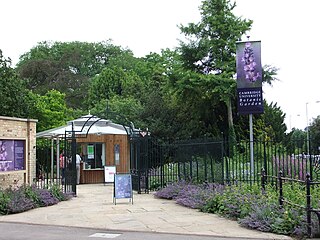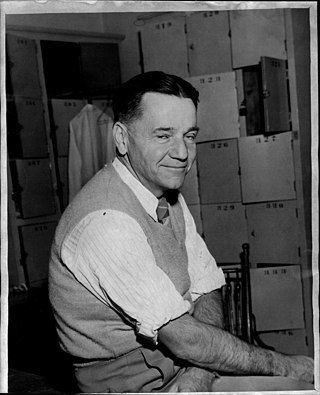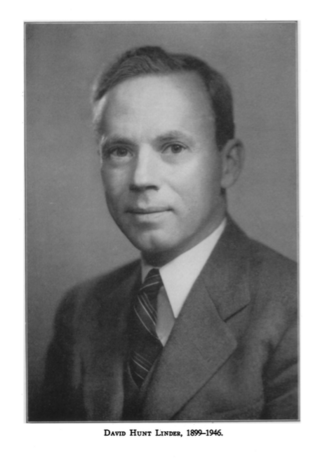Related Research Articles

The Cambridge University Botanic Garden is a botanical garden located in Cambridge, England, associated with the university Department of Plant Sciences. It lies between Trumpington Road to the west, Bateman Street to the north and Hills Road to the east.
Benjamin Minge Duggar was an American plant physiologist. Surprisingly, he is best remembered for his contribution to another discipline, through his discovery in 1945 of chlortetracycline (Aureomycin), the first of the tetracycline antibiotics, from a soil bacterium growing in allotment soil.

Lathyrus nevadensis, the Sierra pea or purple peavine, is a perennial herb with erect to climbing stems, native to the forests and clearings of western North America from British Columbia to northern California and as far east as Idaho.

Charles Leo Hitchcock was an American botanist. He discovered 20 species of plants and his works have been cited thousands of times. He is also the primary co-author to the Flora of the Pacific Northwest, still the most up to date flora for three northwest U.S. States to date. A hall at the University of Washington is named in his honor, and he taught thousands of botanists over the course of his teaching career at the University of Washington.

Edwin Butterworth Mains (1890–1968) was an American mycologist. He was known for his taxonomic research on the rust fungi (Pucciniomycetes), the genus Cordyceps, and the earth tongues (Geoglossaceae).
Harry Morton Fitzpatrick, was an American mycologist. He was professor of mycology at Cornell. He is known for his work on the Phycomycetes. His book on the Lower Fungi was the standard text and reference work on the Phycomycetes. He trained Clark Thomas Rogerson and Richard P. Korf, two prominent mycologists.
Charles Drechsler was an American mycologist with 45 years of research with the United States Department of Agriculture. He spent considerable time working with cereal fungal diseases, and the genus Drechslera was named after him. Drechsler also worked extensively on oomycete fungi and their interactions with vegetable plants. Drechsler was recognized as a leading authority on helminthosporia, oomycetes, and other parasitic fungi.

David Hunt Linder (1899–1946) was an American mycologist known for his work on the Helicosporous fungi and his dedications for the advancement of mycological knowledge. He curated the Farlow Herbarium of Cryptogamic Botany at Harvard University and founded a highly respected journal Farlowia.
Frederick Kroeber Sparrow was an American mycologist. He was known for his research on aquatic fungi, and in particular the genus Physoderma, and he produced a well-received monograph in 1943 titled The Aquatic Phycomycetes Exclusive of the Saprolegniacea and Pythium; this was republished in 1960 as Aquatic Phycomycetes.
Frank Leslie Howard was a prominent American mycologist.
Claude Wilbur Edgerton was an American mycologist. He was born in Woodbine, Iowa, and earned a Bachelor of Science degree from the University of Nebraska in 1903, and a PhD from Cornell University in 1908. After this he was employed at Louisiana State University, initially as a plant pathologist in the Agricultural Research Station, and later as Professor and then Head of Botany, Bacteriology, and Plant Pathology in 1924. Edgerton had this position until his retirement in 1950. He was known for his study of sugarcane diseases; his teaching materials formed the basis of the book Sugarcane and Its Diseases, first published in 1955 after his retirement. Species named in honor of Edgerton include Cryptosporiopsis edgertonii and Synchytrium edgertonii.

Edith Katherine Cash was an American mycologist and lichenologist.
Neil Everett Stevens was an American mycologist and plant pathologist. He served as president of the Botanical Society of Washington (1931), American Phytopathological Society (1934), and Botanical Society of America (1948). His research chiefly concerned fungal diseases of crops such as chestnuts, strawberries, cranberries, currant, and corn. Stevens was born in Portland, Maine, graduated from Bates College in 1908, and earned a PhD. from Yale University in 1911. He was instructor at Kansas State College from 1911 to 1912, then worked at the Bureau of Plant Industry of the U.S. Department of Agriculture from 1912 to 1936. He worked as adjunct professor at George Washington University from 1931 to 1936, then professor of botany and plant pathology at the University of Illinois from 1936 to 1949.
Leland Shanor was an American mycologist and botanist. He married mycologist Mary Williams Ward Shanor on June 20, 1940, in Burgaw, North Carolina. They had two sons. Charles was born in 1946 and Paul in 1949. Outside of their studies in mycology, Leland and Mary Shanor were both heavily involved in real estate. They are both buried in Rockfish Presbyterian Church Cemetery in Wallace, Duplin County, North Carolina.
Elizabeth Eaton Morse was an American mycologist. Born in Framingham, Massachusetts, she graduated from Ashland, Massachusetts, High School in 1882. For seven years she taught in elementary school before entering Wellesley College, from which she graduated with a diploma from the School of Art in 1891. After twenty years of teaching in the New York City schools Morris High School and Roosevelt High School, she returned to Wellesley College in 1924 and earned a degree in Botany in 1926. Shortly after, she registered as a part-time graduate student in the Department of Botany at the University of California, and was given storage and work space to pursue her interests in cryptogamic botany.
Frank Dunn Kern was an American plant pathologist and university administrator. He was a faculty member at Pennsylvania State University, holding appointments as Head of the Department of Botany and Dean of the Graduate School. He was an expert on the Pucciniales.
Frank Lincoln Stevens was an American mycologist and phytopathologist. He gained an international reputation as one of the preeminent mycologists.
John Albert Stevenson was an American mycologist and phytopathologist.
Lewis Edgar Wehmeyer was an American botanist and mycologist. He gained an international reputation as an expert on the genera Pleospora and Pyrenophora.
References
- ↑ Bailey, L.H., compiler. RUS: Rural Uplook Service,a register of the rural leadership in the United States and Canada. 1920 edition.
- 1 2 "Negro educator and wife visit: Charles S Parker collecting specimens on botanical trip across nation". The Spokesman Review. July 22, 1936.
- ↑ Fischer, George W (1951). "Plant Pathology in the state of Washington:Past, Present and Future". Plant Disease Reporter. Supplement 200: 48–49.
- 1 2 Parker, Charles S (1933). "A Taxonomic Study of the Genus Hypholoma in North America". Mycologia. 25 (3): 160–212. doi:10.1080/00275514.1933.12020660. JSTOR 3754210.
- ↑ Henderson, James H M (2001). "Fifty Years as a Plant Physiologist". Annual Review of Plant Physiology and Plant Molecular Biology. 52: 1–28. doi:10.1146/annurev.arplant.52.1.1. PMID 11337390. S2CID 25613046.
- 1 2 3 "News and Notes". Science. 111 (2875): 122. 1950. Bibcode:1950Sci...111..119.. doi:10.1126/science.111.2875.119 . Retrieved July 7, 2020.
- ↑ "History – Research-Oriented Graduate Programs in Biology at Howard University". Biology. Howard University. Retrieved July 7, 2020.
- 1 2 Harvey, Monique; Burke, Janelle. "The Life and Legacy of Dr. Charles S. Parker". Botany2017. The Botanical Society of America. Retrieved July 7, 2020.
- ↑ "Nominations for Membership". Bulletin of the American Association of University Professors (1915–1955). 19 (2): 152. 1933. JSTOR 40218931.
- ↑ Couch, J. N. (1941). "Mycological Society of America: Directory. 1940–1941". Mycologia. 33 (6): 670–701. doi:10.1080/00275514.1941.12020863. JSTOR 3754787.
- ↑ "Howard University". Index Herbariorum. New York Botanic Garden. Retrieved July 7, 2020.
- 1 2 St. John, Harold (1937). Flora of Southeastern Washington and of Adjacent Idaho (1 ed.). Students Book Corporation.
- ↑ International Plant Names Index. C.S.Parker.
- ↑ Hitchc, C L (1952). "Lathyrus nevadensis var. parkeri (H.St.John)". Univ. Wash. Publ. Biol. 15: 45.
- ↑ "Lathyrus parkeri St.John". The Plant List. Retrieved July 7, 2020.